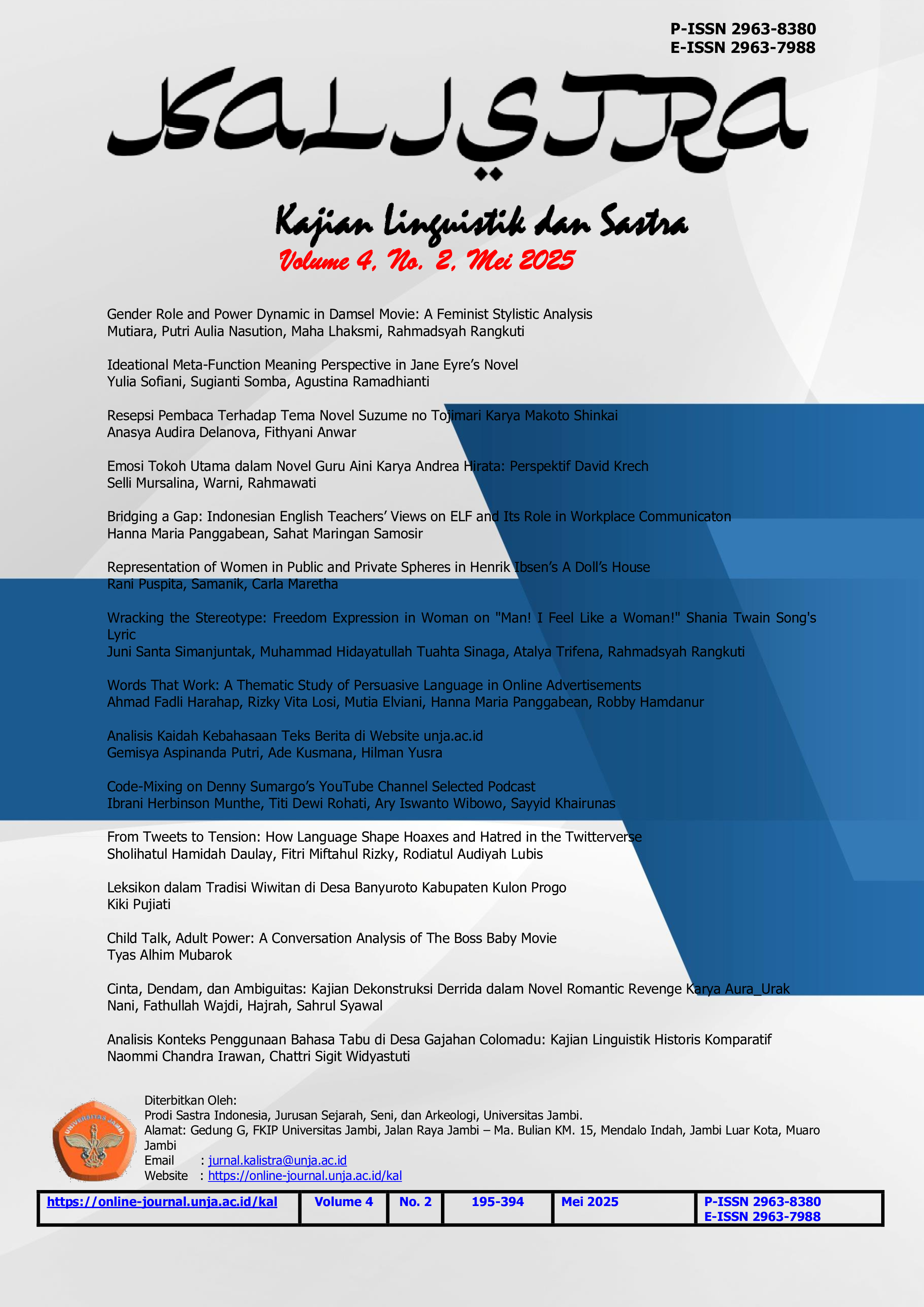Child Talk, Adult Power: A Conversation Analysis of The Boss Baby Movie
DOI:
https://doi.org/10.22437/kalistra.v4i2.44258Keywords:
Conversation Analysis, Language and Power, Speech ActsAbstract
This study examines the interplay of language, authority, and identity in the animated film The Boss Baby through the lens of conversation analysis. Focusing on the film’s unique premise, an infant who speaks and behaves like an adult. The research explores how linguistic features such as turn-taking, speech acts, and power dynamics are employed to construct and challenge traditional roles of childhood and adulthood. This research employs a qualitative method grounded in the principles of Conversation Analysis. By analyzing selected dialogues between the titular baby and other characters, this paper reveals how adult-like language is used to subvert expectations, assert dominance, and create comedic tension. The findings highlight how The Boss Baby uses conversation as a tool to blur age-based hierarchies, offering insights into how media narratives shape and reflect societal understandings of power and communication.
Abstrak
Penelitian ini meneliti interaksi bahasa, otoritas, dan identitas dalam film animasi The Boss Baby melalui lensa analisis percakapan. Berfokus pada premis unik film tersebut, seorang bayi yang berbicara dan berperilaku seperti orang dewasa. Penelitian ini mengeksplorasi bagaimana fitur linguistik seperti giliran bicara, tindakan bicara, dan dinamika kekuasaan digunakan untuk membangun dan menantang peran tradisional masa kanak-kanak dan dewasa. Penelitian ini menggunakan metode kualitatif yang didasarkan pada prinsip-prinsip Analisis Percakapan. Dengan menganalisis dialog terpilih antara bayi tituler dan karakter lain, penelitian ini mengungkap bagaimana bahasa seperti orang dewasa digunakan untuk menumbangkan harapan, menegaskan dominasi, dan menciptakan ketegangan komedi. Temuan tersebut menyoroti bagaimana The Boss Baby menggunakan percakapan sebagai alat untuk mengaburkan hierarki berbasis usia, menawarkan wawasan tentang bagaimana narasi media membentuk dan mencerminkan pemahaman masyarakat tentang kekuasaan dan komunikasi.
Downloads
References
Azennoud, A., Achraf Guaad, & Khawla Lamghari. (2025). Interactional Practices and Normative Expectations in EFL Classrooms: A Conversation Analysis Approach to Turn-Taking. Journal of Humanities and Social Sciences Studies, 7(2), 01–14. https://doi.org/10.32996/jhsss.2025.7.2.1
Bucholtz, M., & Hall, K. (2005). Identity and interaction: A sociocultural linguistic approach. Discourse Studies, 7(4–5), 585–614. https://doi.org/10.1177/1461445605054407
Chiaro, D. (2006). The Language of Jokes: Analyzing Verbal Play. Taylor and Francis.
Crystal, D. (2003). English as a Global Language (2 ed.). Cambridge University Press. https://doi.org/10.1017/CBO9780511486999
Darong, H. C. (2024). Conversational Analysis: Types and Function of Speech Acts in EFL Classroom Interactions. Journal of Languages and Language Teaching, 12(3), 1191. https://doi.org/10.33394/jollt.v12i3.11001
Fairclough, N. (1996). Language and power (10. impr). Longman.
Giovanelli, M. (2018). Construing the Child Reader: A Cognitive Stylistic Analysis of the Opening to Neil Gaiman’s The Graveyard Book. Children’s Literature in Education, 49(2), 180–195. https://doi.org/10.1007/s10583-016-9285-3
Gosen, M. N., Willemsen, A., & Hiddink, F. (2024). Applying conversation analysis to classroom interactions: Students’ ‘oh’-prefaced utterances and the interactional management of explanations. Classroom Discourse, 1–19. https://doi.org/10.1080/19463014.2024.2397127
Hamann, M., Thrower, S. N., Stokoe, E., & Harwood, C. G. (2025). What determines (in)effective post-competition parent-child interactions in British Tennis? A conversation analysis of car journeys home. Psychology of Sport and Exercise, 79, 102840. https://doi.org/10.1016/j.psychsport.2025.102840
Holmes, J. (with Stubbe, M.). (2015). Power and politeness in the workplace: A sociolinguistic analysis of talk at work. Routledge. https://doi.org/10.4324/9781315750231
Kilpiä, A., Dindar, K., Kärnä, E., Räty, H., Kämäräinen, A., & Suero Montero, C. (2023). Using conversation analysis to identify unresponsiveness in peer interactions in inclusive groups. Journal of Interactional Research in Communication Disorders, 14(3), 386–407. https://doi.org/10.1558/jircd.24391
Mubarok, T. A. (2021). An Analysis of Linguistic Features of Evaluative Stance Found in Research Articles’ Introduction. Briliant: Jurnal Riset Dan Konseptual, 6(4), 933. https://doi.org/10.28926/briliant.v6i4.753
Mubarok, T. A., Nisak, W. K., & Firmanda, Y. (2022). An Analysis of Speech Act on Civil War Movie. Proceedings of the International Seminar on Business, Education and Science, 1, 130–141. https://doi.org/10.29407/int.v1i1.2515
Nafisah, N., Sarumpaet, R. K., & Tjahjani, J. (2020). The Ambivalent Construction of Child Characters’ Subjectivity in Four Indonesian Children’s Films. Proceedings of the 3rd International Conference on Language, Literature, Culture, and Education (ICOLLITE 2019). 3rd International Conference on Language, Literature, Culture, and Education (ICOLLITE 2019), Bandung, Indonesia. https://doi.org/10.2991/assehr.k.200325.111
Noorman, S., & Nafisah, N. (2016). Contesting Indonesia in children’s films: An analysis of language use and mise-en-scène. Indonesian Journal of Applied Linguistics, 5(2), 294. https://doi.org/10.17509/ijal.v5i2.1353
Sacks, H., Schegloff, E. A., & Jefferson, G. (1974). A Simplest Systematics for the Organization of Turn-Taking for Conversation. Language, 50(4), 696. https://doi.org/10.2307/412243
Schegloff, E. A., Jefferson, G., & Sacks, H. (1977). The Preference for Self-Correction in the Organization of Repair in Conversation. Language, 53(2), 361. https://doi.org/10.2307/413107
Toolan, M. J. (2001). Narrative: A critical linguistic introduction (2nd ed). Routledge.
Tsinghua University, & Han, X. (2024). From Conversation to Interaction: A Pedagogical Exploration of Applying Conversation Analysis in EFL Classrooms. Teaching English as a Second or Foreign Language--TESL-EJ, 28(3). https://doi.org/10.55593/ej.28111a7
Wilkinson, R. (2024). Conversation Analysis and Communication Disorders. Dalam M. J. Ball, N. Müller, & E. Spencer (Ed.), The Handbook of Clinical Linguistics, Second Edition (1 ed., hlm. 69–80). Wiley. https://doi.org/10.1002/9781119875949.ch6
Downloads
Published
How to Cite
Issue
Section
License
Copyright (c) 2025 Tyas Alhim Mubarok

This work is licensed under a Creative Commons Attribution-ShareAlike 4.0 International License.
Kalistra: Kajian Linguistik dan Sastra is licensed under Creative Commons Attribution-ShareAlike 4.0 International License.
Authors who publish their manuscripts in Kajian Linguistik dan Sastra agree to the following terms:
1. The copyright in each article belongs to the author.
2. The author acknowledges that Kajian Linguistik dan Sastra reserves the right to be the first to publish under a Creative Commons Attribution-ShareAlike 4.0 International License (Attribution 4.0 International CC BY-SA 4.0).
3. Authors may submit articles separately, arranging for non-exclusive distribution of manuscripts that have been published in this journal to other versions (e.g., delivery to the author's institutional repository, publication into a book, etc.), acknowledging that the manuscript has been first published in Kajian Linguistik dan Sastra.
















